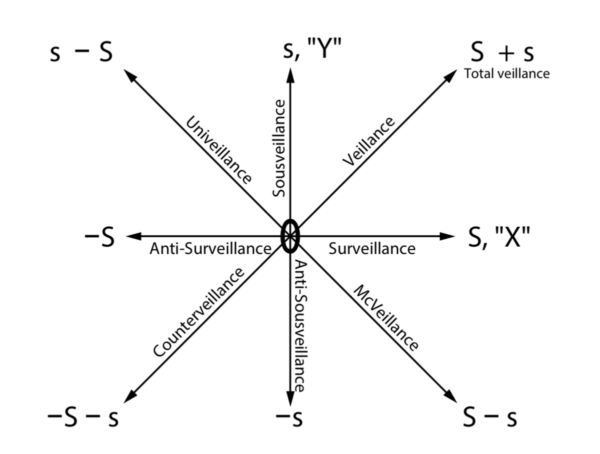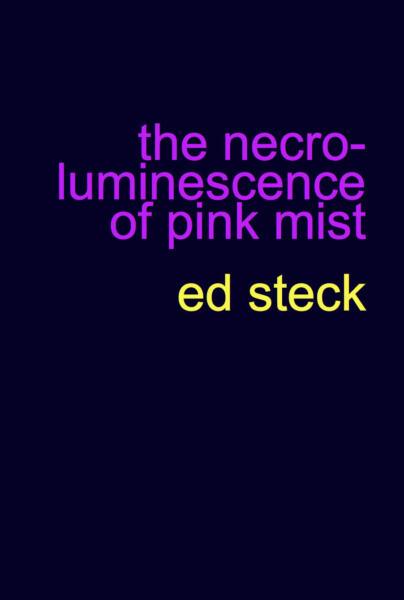
Solaris (1972) Directed by Andrei Tarkovsky
Previously in “Notes Toward a Virtual Poetics“:
What are the poetics new media technology makes possible, and how does new media’s complicity with processes of racialization both change and charge, for artists and writers, the politics of choosing to work with these technologies?
◈
“Vision always comes true. Vision is the realest thing there is.”
—Laure (Colette) Peignot, via Kathy Acker
Manuel Castells, an early theorist of the virtual, claimed in The Rise of Networked Society (1996) that “the multimedia world will be populated by two essentially distinct populations: the interacting and the interacted” (371). One important discursive framework for reading this divide is through the theory and technologies of surveillance. Inventor and social theorist Steve Mann devised a graph, a Veillance Plane, capable of supporting the many possible veillance positions in any given society.

The two most important terms, inasmuch as they relay the watcher’s position of power, are surveillance and sousveillance. Surveillance means “oversight”, via the French prefix sur– meaning ‘from above’, and the root -veillance via the French verb veiller meaning to watch or observe. Sousveillance, on the other hand, holds the prefix –sous meaning ‘from below’ or ‘underneath’; as a political position, we might take this to mean “to watch the watcher.” The problem with the Veillance Plane, however, is that an individual at any one moment can occupy multiple positions at the same time. If we understand the technologies that allow this kind of vision, this gaze, as expressions of state power, then our imbrication, as US citizens, in the matrices of power and violence is not binary, but rhizomatic, interactive and characterized by exchange.
Castells’ assertion, in other words, doesn’t capture the whole picture, but points crucially to the ways existing class-based, often racialized economic divides might be facilitated (if not exacerbated) by current media technologies. Today, the media interfaces we touch or click daily serve as important tactile, even haptic examples. A web browser’s interface, and more often than not the physical interface of our smartphones serve as sites (and surfaces) through which matrices of power and violence interact, and can be similarly exchanged. Reflecting on the music video for Jennifer Lopez’s “If You Had My Love,” theorist Lisa Nakamura, in Digitizing Race, makes a case for the ways media interfaces do not confer race neutrally, but are instead complicit in the effects of racialization on the body:
“the interface serves to organize raced and gendered bodies in categories, boxes, and links that mimic both the mental structure of a normative consciousness and set of associations (often white, often male) and the logic of digital capitalism: to click on a box or link is to acquire it, to choose it, to replace one set of images with another in a friction-free transaction that seems to cost nothing yet generates capital in the form of digitally racialized images and performances” (17).
As it is with the gaze, the power play between the user and the interface can be asymmetric, rhizomatic, and on the whole racialized. From Nakamura’s observation, we can see the ways racialized bodies can be imagined as tactile surfaces, or might themselves learn to become, through exposure, what Nakamura describes as objects of interactivity. This formulation reveals crucially the materials through which race might act (like theorists Ruha Benjamin and Wendy Chun argue) as a ‘technology’ of power—a technology through which U.S. racialized bodies become fraught surfaces, made to mediate, as Toni Morrison suggested, in persistent and complicated ways. When Ruha Benjamin says succinctly that “users [also] get used” (14), the rhizome of ‘use’ I want to emphasize begins to take shape.
The complicity of this position, of this object of interactivity, evokes Julia Kristeva’s formulation surrounding the abject: a self who, in attempting to define the boundary where their self ends, realizes instead that “self-ness” itself is what ends, what “falls into a faint,” and arrives in a non-state in which “elsewhere” enters; arrives inside the self’s “here, jetted, abjected into” their newly borderless world (Kristeva, 231). Becoming the border between self and other offers another way of inhabiting the racialized surface Hartman describes; but while the abject, indeterminate state endured by the body can be world-shattering–this exceptional “faint” Kristeva describes is by no means out of the ordinary. On the contrary, abjection is both a normalized feature of, and even common to the experience of being racialized, institutionalized, instrumentalized, and mediated—indeed, of being used—by systems of power under which the self cannot be defined as either subject or object, but as something in between.
Surrogacy, and the categorical instability the mediating surrogate endures, extends far beyond chatel slavery. Reflecting on my own experiences working in warehouses and factories, or even now, in states of emergency, as our current pandemic crisis reveals, the expectations placed on essential laborers to mediate larger apparatuses of control, apparatuses with which they/we have no choice but to comply, show us that being seen as and treated like an object of interactivity is a persistent condition of everyday life. A condition responsible for, in part, how invisibly we might enact, as interactive borders not just between ourselves and others, but between others and the state, the stratification of racial, gendered, and class-based inequities. As artists, the first step in subverting this virtual, political reality, is acknowledging also that poems and other art-objects endure a similarly violent state of mediation, but do not need to endure this state transparently. Vision, in other words, doesn’t always have to come true.
◈
In poet Muriel Rukeyser’s The Book of the Dead, one so-called ‘documentary’ poem activates (on sight) a colonial, exploitative logic adjacent to the logics of digital capitalism Nakamura describes. Rukeyser’s poem doesn’t describe but demands: “Select the mountains… / travel the passes,” and “Touch West Virginia where // the Midland Trial leaves the Virginia furnace.” Rukeyser’s poem doesn’t sit back like a retinal scanner, simulating for the reader, for the conquering eye, a landscape who can perform a similarly abject position. The poem becomes instead an impossible interface both prompting a user to enact its seemingly invisible “I”, and extracting from the reader the labor of simulation. But does the user or the used enact the poem? Does the poem and its surrogate, mediating landscape become racialized in the process? In poems who labor not to enact any collapse between the “I” and the scenes described, who keep their distance, like Solaris this subversive surface feels anomalous, challenging, and vital.
The writer and poet Ed Steck, an aesthetic interlocutor, gives us some language with which to think through this surface. When commenting on his book, Necro-luminescence of Pink Mist, Steck says that he was looking towards “model landscapes, or abstractions of landscapes, as [stages] for collective or projected trauma”—considering, as we might about Solaris, how these “fantastic” worlds reflect “the anxieties and fantasies of our terrestrial world” (Gallagher). How might these model landscapes inform our encounter with the opaque, plaster-like surface the Solarian ocean simulates for, or reacts against, the pilot Burton? Against vision itself?
Within the hegemonic traditions of poetic forms, the pastoral poem offers us a different counterfeit landscape: a pasture, an enclosure, whose shepherd sings both inside the poem, and as the poem—a shepherd (that is, a speaker) whose voice both utters as, and utters into being, every object seen or heard within the enclosure, i.e. within the limits of the poem. This model occasions a collapse between the text and the speaker, whereby the poem speaks as the poem itself. If the surface of Solaris can speak, both as a landscape and as a text, what does its lyric “I” want to say? Through Burton’s testimony, the surface of Solaris resists this pastoral model defined by fixity and communicability.

Solaris (1972) Directed by Andrei Tarkovsky
In Tarkovsky’s film, the ocean’s surreal vistas, both before and after arriving fitfully as garden simulacra—as “shrubs, hedges,” and kitsch little “acacia trees”—are constantly in flux, arriving first as “yellow sludge,” ‘seething’, reportedly “[rising] up in thin strips [sparkling] like glass.” The ‘like’-ness of this fluidic surface, as with the language deployed to apprehend it, evinces its generic instability. This same instability is of critical importance to poet and critic Joyelle McSweeney, who offers us a capacious counter-model “remarking the pastoral as a zone of exchange,” which she aptly calls the necropastoral—a site defined by flux, porousness, and ‘suppuration’: ”a political-aesthetic zone in which the fact of mankind’s depredations cannot be separated from an experience of ‘nature’ which is poisoned, mutated, aberrant, spectacular, full of ill effects and affects.”
If the project of colonial occupation survives, says literary and political theorist Achille Mbembe, “[by] writing a new set of social and spatial relations on the ground,” by the grafting “of boundaries and hierarchies, zones and enclaves,” by resource extraction and, “finally, the manufacturing of a large reservoir of cultural imaginaries,” then the shifting Solarian surface offers bodily, topographic resistances to this assimilative project (79). In reading Solaris as a necropastoral site, then, we might consider among human kind’s many ecological depredations, as would Achille Mbembe (whose essay on Necropolitics has had a profound influence on McSweeney), the assimilative, even genocidal violences endemic to colonialism. Thinking of this assimilative history, the resistance enacted by the Solarian surface takes on new meaning—becomes, like art, a counter-act of unapologetic difference.
“Agree not merely to the right to difference,” demands the Martiniquan poet and theorist, Édouard Glissant, “[but] agree also to the right to opacity” (190). This resistant plea defines, for Solaris, a political and racialized charge to this landscape’s “opaque” texture: a text which, as Glissant might explain, “is not obscure, [but] is that which cannot be reduced,” ‘grasped’, or apprehended (193). When enacted as a verb, this sense of ‘apprehension’ collapses the distinctions between ‘understanding’ and ‘enclosure’, bringing us closer to the epistemological and colonial violations the Solarian surface might seek, like Glissant, to resist. In this case, Solaris stages its resistance against the Western gaze, whose inciting violation arrives in the form of a demand: a demand for transparency.
Madison McCartha is a black, queer multimedia artist and poet whose work appears or is forthcoming in Black Warrior Review, Denver Quarterly, The Fanzine, jubilat, Prelude, Tarpaulin Sky, and elsewhere. Their debut book-length poem, FREAKOPHONE WORLD, is forthcoming from Inside the Castle in 2021. Madison holds an MFA from the University of Notre Dame and is a PhD student at UC Santa Cruz. @MadisonMccartha

